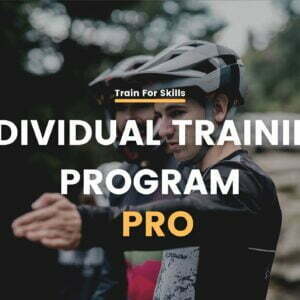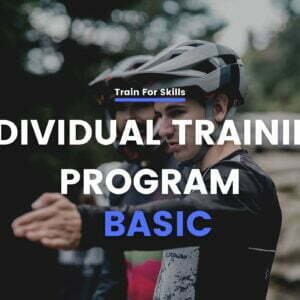What to eat and drink while cycling?
This is a question most riders ask themselves. In this text, we will present the basic principles of nutrition during cycling and endurance training.
Quite a few athletes are aware of the fact that a meal, referred to as a “pre-workout”, should be consumed before prolonged and intense exercise. An analogy can be used here for refueling a car before a long trip. We must have a supply of fuel to cover the route we have planned without surprises. After the workout it’s time for the post-workout meal, which, according to our observations, receives the most attention. Athletes are generally aware of the need to consume adequate amounts of carbohydrates and protein to replenish lost components.

Back to our analogy. After returning from a long trip, we also try to refuel the car, for example, to get to work in the following days.
The athletes we work with or have worked with are aware of the need for pre and post workout meals. On the other hand, on-trail nutrition during workouts lasting from an hour to even a few is often neglected and overlooked.
1. What are the benefits of eating during exercise?
When we bring up the topic of eating during exercise, we mainly mean providing carbohydrates. The use of such treatment under appropriate conditions can bring a number of benefits that will translate into improved exercise capacity. Among other things, this will prevent blood glucose from falling below normal (hypoglycemia). Additionally, as a result of providing an energy substrate (fuel) for working muscles, muscle glycogen will be spared.
To understand why carbohydrates are the key macronutrient, we need to dig a little deeper into the physiology of exercise. Our muscles mainly use glucose and fatty acids to work. On the other hand, which “fuel” contributes a greater percentage to energy processes depends mainly on the intensity of the exercise. This relationship is well illustrated in the chart below.

As you can see, the higher the intensity of our exercise, the more important carbohydrates are. Of course, the fact that it’s glucose that plays a more important role in more intense workouts doesn’t mean we have to keep supplying it. As we know, it is stored in the form of glycogen in our muscles and liver, acting as an energy reservoir. However, one must ask the question – how large are such reserves? See the image below.

A 70 kg man is able to store enough muscle glycogen to cover ~2000 kcal. In comparison, there is over 30 times more energy stored in fat cells, and this is for an athlete with only 12% body fat (abdominal muscles are already visible). It is worth mentioning that glucose is also used by our nervous system. Maintaining its optimal concentration in the blood is a very important issue. In addition, glycogen stored in the muscles is only used in a local capacity (it is fuel only for the muscle). In turn, it is the liver that ensures that blood glucose levels are kept in check. To answer the question posed above. Reserves in the form of glycogen are limited and can be a limiting factor in our exercise capacity when they become significantly depleted.
Another reason why you should take care of your carbohydrate supply is that carbohydrates are a very efficient substrate. From the same amount of precious oxygen, our body is able to produce more energy using glucose.

But do theoretical assumptions about exercise physiology translate into practice?
A study by JohnEric W. Smith in 12 cyclists examined the effects of glucose delivery during exercise on performance. They consumed one of four beverages during a 2-hour ride using an appropriately configured bicycle trainer:
- placebo drink,
- A beverage that provides 15 g of glucose/hour,
- A drink that provides 30 g of glucose/hour,
- a drink that provides 60 g of glucose /h).
They were then asked to run a distance of 20 km in as little time as possible (no fluids were given here).
Consuming glucose during exercise improved time trial performance. An average of almost 2 minutes difference between the placebo group and the 60 g glucose/h group. Glucose consumption increased mean power output, as shown in the table below.

Using the results from this or other papers on similar topics as examples, we can make the following conclusions. By providing carbohydrates during prolonged exercise, athletes can significantly improve their performance.
3. When should an athlete take care of nutrition on the road?
This will mainly depend on the length and intensity of your workout. Most of the data are consistent. If you plan to exercise for more than two hours, carbohydrates should be consumed in that case.
For shorter duration (~1h) high intensity workouts, carbohydrates can also have a positive effect on performance. However, a different mechanism is responsible for this than for efforts lasting >2h. In these situations, rinsing the mouth with a carbohydrate solution seems to be a promising practice, which is supported by many studies. This effect is caused by stimulation of receptors in the mouth. This suggests to us that carbohydrates may also affect the nervous system, helping to improve performance. However, the receptors that mediate this mechanism have not yet been precisely identified; despite this, the findings are very promising. In practice, this does not necessarily mean rinsing your mouth with a drink and then spitting it out. Equally, when reaching for a bottle of isotonic, simply hold the drink in your mouth before swallowing. This will likely result in additional benefits.
In one study, cyclists were asked to cover a distance of 40 km (the effort took about 1 hour). The group of riders who consumed a carbohydrate-electrolyte solution during the ride had an average improvement of 2.3%. Because the duration of exercise was too short (not enough for glycogen stores to be depleted or for hypoglycemia to occur), the reason for the observed ergogenic effect (improvement in exercise capacity) remained unclear.
The study was repeated with one difference. The contestants merely rinsed their mouth with the carbohydrate solution (a non-sweet, tasteless maltodextrin solution) for 5 seconds and then spit it out. The results of the experiment were very similar, with the riders who rinsed their mouths with the solution recording an average 2.8%improvement.
Use the code“TFS10” to receive a 10% discount on all supplements from Placebo Nutrition. We guarantee that their products will help you provide the right ingredients before, during and after your workout.
4. How much to eat and what foods to choose?
Quantitative carbohydrate selection will also be influenced by the length and intensity of our exercise. Fortunately, through research on the subject, we have reached some consensus. For this reason, we have guidelines on the amounts to aim for when you are going to provide carbohydrates.

As you can see, in addition to the duration of exercise as well as the recommended amounts, we also have mention of the type of carbohydrate. More specifically, how they are absorbed from the digestive tract. Well, glucose uses a sodium-dependent transporter (SGLT1 for short) for absorption, but this reaches its limit at about 60 g of carbohydrate/h. So if we base our dietary protocol only on carbohydrate sources that utilize SGLT1, even though we consume more than the mentioned 60 grams, we will not reap the maximum benefits. In contrast, when fructose was administered in addition to glucose and its polymers in the study, the oxidation rate increased above 60 g/h. Fructose uses a different transporter called GLUT5. Thus, by using a combination of different carbohydrate sources, we are able to oxidize them in greater amounts. This is applicable for exertion of more than 2.5 hours.

In one study, the authors aimed to compare the effects of glucose alone (1.8 g/min = 108 g/h) and glucose combined with fructose (also 1.8g/min) in a 2:1 ratio. The outcome was analyzed in a test corresponding to approximately 1 hour of driving at high intensity, preceded by 2 hours of driving at medium intensity.
The riders providing a combination of both carbohydrate sources performed 8% better than the glucose-only group, which in turn performed 10% better than the placebo (water) group.
When choosing the products we are going to take with us for a long training or competition, we need to pay attention to several important issues:
- First, these foods must be a significant source of carbohydrates and contain negligible amounts of dietary fiber, protein, and fat. Choosing such products will ensure that food does not linger in the stomach for long.
(2) Second, products can be supplied in either liquid, semi-liquid or solid form. However, the final choice must be tailored individually to the athlete. For example, products in liquid or semi-liquid form are easier to consume on the go, however they fare less well in terms of providing satiety. Additionally, there is the issue of the athlete’s taste preferences, the need to drink certain foods, body positioning during exercise, the specifics of the sport or the intensity of the activity.
3. ThirdIf we plan a longer workout, we need to make sure that some of the products contain different types of carbohydrates (besides glucose or maltodextrin, they contain fructose for example). This will allow them to be oxidized in larger quantities. Fructose is added to energy gels, among other things, but is also found in fruit or regular table sugar (sucrose is a mixture of glucose and fructose). However, keep in mind that fructose in large amounts can exacerbate gastrointestinal problems.
The most commonly used products include isotonic drinks, energy gels and bars, dried fruit, bananas, rice cakes or jellybeans.

5. Gut training
Perhaps some athletes will want to change something in their competition preparations after reading this article. However, keep in mind that if you have never done this then you need to approach it with the right strategy. Values on the order of 90 g of carbohydrate per hour already require adequate preparation. It is important to take into account that our digestive tract does not function optimally during exercise. If you want to take in increasing amounts of carbohydrates and also reduce the risk of gastrointestinal problems you need to implement what is known as gut training.
The digestive tract is highly adaptive. It has been suggested that his targeted training may improve nutrient delivery during exercise, or alleviate some gastrointestinal symptoms at the same time. This will result in improved exercise capacity with high digestive comfort.
One of the problems when consuming carbohydrates during exercise can be volume. If your stomach is not adapted to consume large amounts of food and liquids, this can result in discomfort. This discomfort can manifest itself in the form of bloating and an oppressive feeling of fullness, which will certainly not benefit performance. If this is the case, introduce training units where we expose our digestive system to a “new stimulus”. The easiest method would be to gradually increase your carbohydrate intake during your workout. If so far the athlete has consumed 10 g of carbohydrate for each hour of exercise, on the next occasion he may include 30 or 40 g and so on. It is then very important to observe and note your digestive comfort. Based on the lessons learned, we will know what limits we have reached during training and thus create an optimal strategy for the competition day.
Other methods reported in the literature include training immediately after eating a meal or after consuming plenty of fluids. On the other hand, it’s important to remember that athletes rarely eat a hearty meal moments before getting on the bike. Therefore, relying on this method alone does not fully represent the starting circumstances.
In addition, eating a high-carbohydrate diet on a daily basis also has a positive effect on the rate of gastric emptying or the rate of carbohydrate oxidation. Some scientific papers suggest that just a few days of a high carbohydrate diet is enough to significantly improve the previously mentioned parameters. Nevertheless, prolonged use may result in greater adaptations.

The selection of carbohydrate sources consumed during exercise is also a critical aspect. It can be a cardinal mistake to take jellies and dates to the competition when you have only used energy gels during training. Any new product is worth checking for possible gastrointestinal problems before you decide to use it during important events.
6. Remember
- Carbohydrates are a key macronutrient when exercise intensity increases.
- Glucose stored in the form of muscle and liver glycogen, is a certain energy reservoir. However, these reserves are limited and can be a limiting factor in our ability to exercise when they become significantly depleted, especially during long and intense efforts.
- Providing carbohydrates during intense workouts lasting over 2 hours can prevent glycogen depletion, thus improving our performance. For shorter efforts – about an hour long – it may be beneficial to rinse the mouth with carbohydrates.
- Depending on the duration of activity, you should provide 30 to 90 g for each hour of exercise.
- These assumptions can be met by using low-fat, low-protein, and low-fiber foods. These products include: drinks, gels and energy barsfor athletes or conventional foods. The choice should depend on the practicality of the product, the discipline, the duration and intensity of the exercise, as well as the individual taste preferences of the athlete.
- For higher amounts of carbohydrates(over 60 grams), bowel training is required. Also make sure to have a variety of carbohydrate sources (e.g., glucose or maltodextrin + fructose)
- Remember to test every strategy and product in training to avoid surprises during an important competition.
- Carbohydrates consumed during exercise also count towards your energy balance.
References:
- Jeukendrup, A. E., & Chambers, E. S. (2010). Oral carbohydrate sensing and exercise performance. Current Opinion in Clinical Nutrition and Metabolic Care, 13(4), 447-451
- Jeukendrup AE. Training the Gut for Athletes. Sports Med. 2017;47(Suppl 1):101-110.
- Jeukendrup A. A step towards personalized sports nutrition: carbohydrate intake during exercise. Sports Med. 2014;44 Suppl 1(Suppl 1):S25-S33.
- Burke, L. Deakin V. Clinical Sports Nutrition. 5th ed. McGraw-Hill, Sydney, Australia 2015
- Smith JW, Zachwieja JJ, Péronnet F, et al. Fuel selection and cycling endurance performance with ingestion of glucose: evidence for a carbohydrate dose response. J Appl Physiol (1985). 2010;108(6):1520-1529.
- Egan B, Zierath JR. Exercise metabolism and the molecular regulation of skeletal muscle adaptation. Cell Metab. 2013
Authors: Dietektywi





